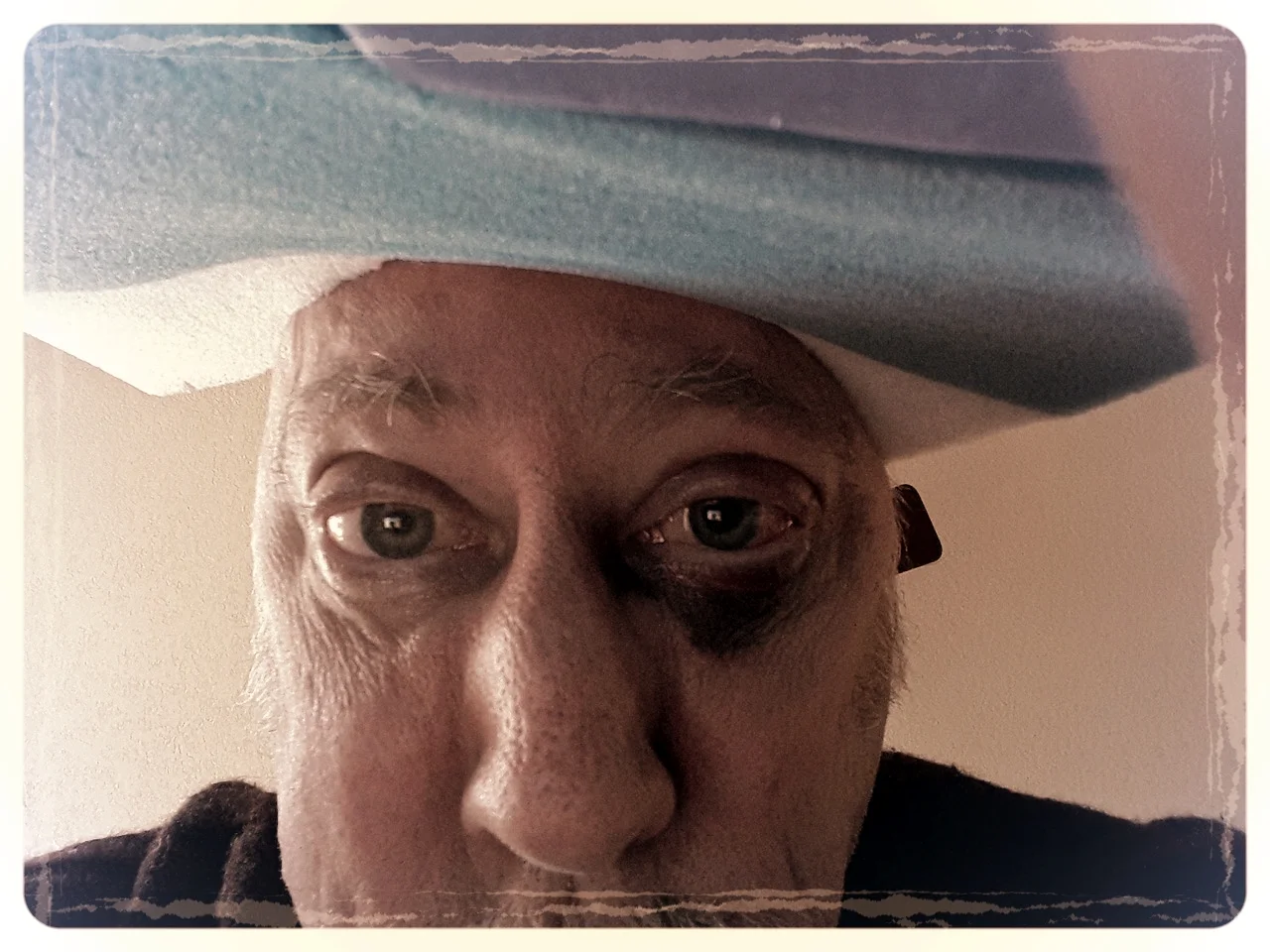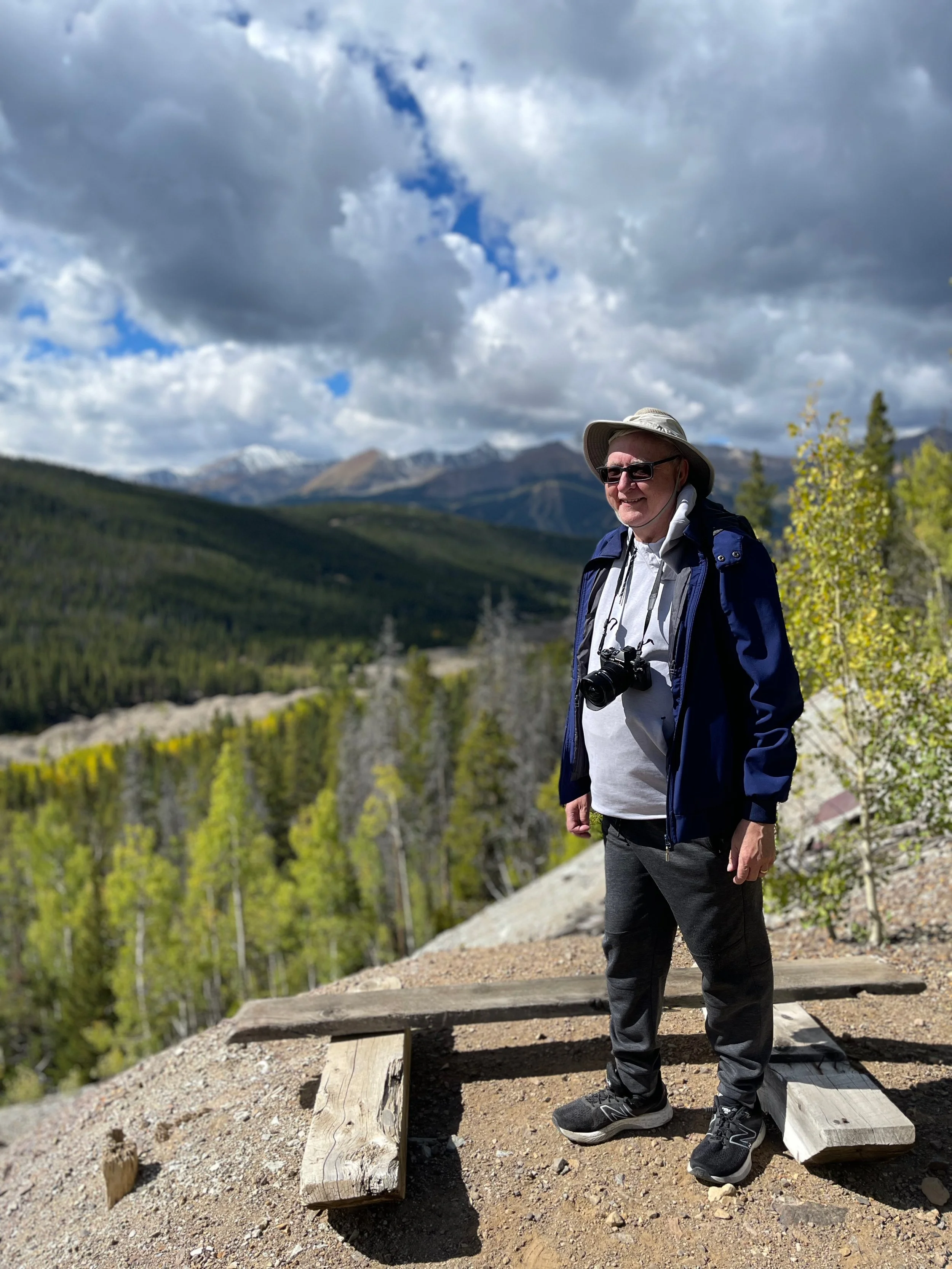Journey To The Center Of The Eye
by Thomas Gump
I was seated at the table, my face in the soup. I was not going to move; it was my destiny.
How did that happen?
While looking at my computer screen, I suddenly saw black streaks floating like snakes in one eye. They looked like drops of dark food coloring in water, slightly swirling. A few minutes later, my partner, Carolyn walked in. I was still mesmerized by the psychedelic patterns in my eye when she started talking. I turned to look at her and noticed she was quite blurry because by now the swirling snakes had morphed into a thick screen of tiny dots. I told her what was going on and she said emphatically, “Call the doctor!”. So I did.
At the doctor’s office in Santa Fe, an ophthalmologist examined me, but then told me to go see the retinal specialist upstairs. That’s when I knew it was serious. Doctor number two told us I had a retinal tear in, surprisingly, both eyes, and one was detached. Staying late, he then did a laser procedure on each eye. My whole life I’ve heard: “Don’t look into the sun!” Well, these lasers had to be brighter than any old sun.
Zap!
The machine made a loud, clunky sound while an incredibly bright flash hit my retina.
Zap!
Zap!
He explained retinas don’t have pain receptors, but the brain may translate the intense light as pain.
Zap! Pow!
Yes, my brain was translating pretty well.
Zap! ZAP!
Freaky. Daze inducing. I told my brain this was all for the best while I held my head rock steady, as directed.
ZAP! POW! ZAP!
Then the other eye.
ZAPOW!
Finally, it was over and he said, “The right eye looks good, it’ll heal. But in the left eye, a blood vessel opened when the retina detached, and, although I tried valiantly, it will need to be operated on ASAP.” I learned one could indeed be valiant while operating a medical device. He kept talking: “It’s a good thing you got here soon,” and “Everything’s going to be alright,” and finally, “We’ll be with you every step of the way.” I was still dazed after all that zapping.
In the morning the hospital in Albuquerque called and set up an appointment for surgery. They told us we should get a hotel room because a follow-up was necessary the next morning, but first we were to meet the surgeon. So off we went, bags packed, to see doctor number three.
The retinal surgeon reaffirmed the diagnosis. He explained that he was going to do a vitrectomy, which takes out the eye’s vitreous gel, and replaces it with a gas, octafluoropropane. Wait, propane? Would I have to keep matches away from my eye? No. It’s inert and not a petroleum product. Whew. There would be a six-week recovery period.
Later, in pre-op, I got an IV while we talked with the jovial nurses and waited. In came the anesthesiologist. A real joker, this one. He played fast and hard with rapid-fire questions: “Do you smoke?” “Do you drink?” “Are you pregnant?” “Currently, no,” I said as I tried to keep up with him joke for joke. He informed me, seriously, that I would be sedated, but awake, during the operation, except for when the doc sticks a needle in there to numb up my eye. Gulp. Awake? What if… I was assured everything would be fine. Sure buddy, you’re the one on the sidelines.
They finally wheeled me into the OR. Showtime. I came to and there was the doc’s face above me, voices around. I was seeing fabulous colors and patterns. I could also see a needle in my eye.
Weird.
Freaky weird.
But painless, so I relaxed and watched the show. Soon it was over. I was out of it from the Versed but had a little pain, so they added fentanyl to my cocktail. In post-op, Carolyn was writing down all the instructions. I was barely able to take in everything that had just happened.
I understand recovery periods, but this? For a week I had to hold myself still with my face down, at least 80% of the time, in order to keep that gas bubble floating up against the reattachment on the back of my eyeball. This is called “positioning.” To accommodate that, I was given a thick foam square, with holes cut out for eyes, nose, and mouth, to stick my face into. I could only sleep on my right side, never on my back. Also, I could not lift heavy weights, move suddenly, drive, read, or really do much of anything. It’s ingenious yet so primitive.
At 7 AM the next morning, the surgeon checked me out and said my eye looked fine. I was not to go above 7500’ in elevation. Santa Fe sits at 7000’. Albuquerque is at 5000’, so he said to drive slowly back home.
Even in the car, my head was buried in my new foam friend. We stopped in Madrid for some lunch and a bit of reality after those quite unreal couple of days. Soon we were home.
For the next week, my face was in the soup. I sat at the table, my face in the soup. I sat at my desk, my face in the soup. I “watched” TV, my face in the soup. I thought, “This is my life now.”
Carolyn had to put on my socks (I was not allowed to bend down), she made my meals (I was only allowed 20 minutes to eat), she read my computer screen for me. She was walking in my shoes. She was becoming me because I was not allowed to.
I was a dependent child again. A baby, an infant. A mere gleam in a womb, hovering, waiting. Much of the time I kept my eyes closed, wondering who I was and who I would be without eyes.
It was a slow, quiet time. I discovered YouTube lectures, audiobooks, silence. I even started meditating again. I had all the time in the world. Suddenly I was having vivid dreams, as my life became virtual. But sleeping was a challenge. The single sleep position flattened my right ear and hurt half my head. I got up only because I couldn’t take it anymore.
That week finally ended and we drove to the doc in Santa Fe, my face dutifully down. Doctor number four checked me out and said healing was pacing normally. But, in his opinion, I should be positioning for ten days, not seven, and to maintain it for 90% of the time. So I had to do three more hardcore days.
They went by, a little faster because I knew there was an end date. On day 10, Carolyn and I were sitting at the kitchen table, my face in the soup, quiet. Suddenly I said, with apparent earnestness, “I’m going to miss this.” Laughter. I was, however, grateful for the opportunity to slow down my brain, my thoughts. That was good.
Day 11 came, at last! I could start doing some normal activity: make my meals, retrieve things for myself, read! And I could finally clean that damn soup off my face.
After several careers, in computer repair, teaching, woodworking, and welding, Tom Gump became disabled in 2005. He had leukemia and then a successful bone marrow transplant. Survival meant, however, many health ups and downs, of which he write.




